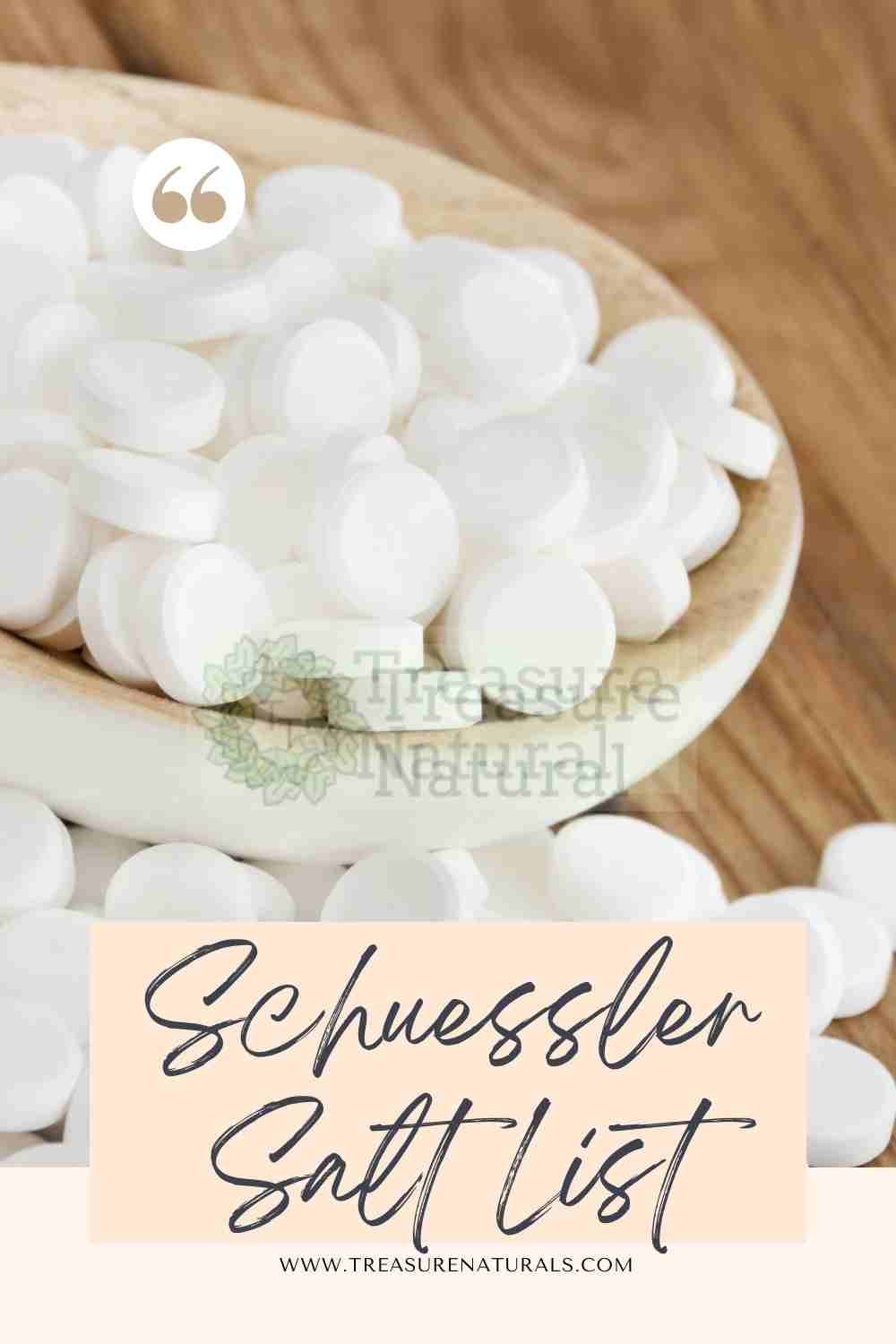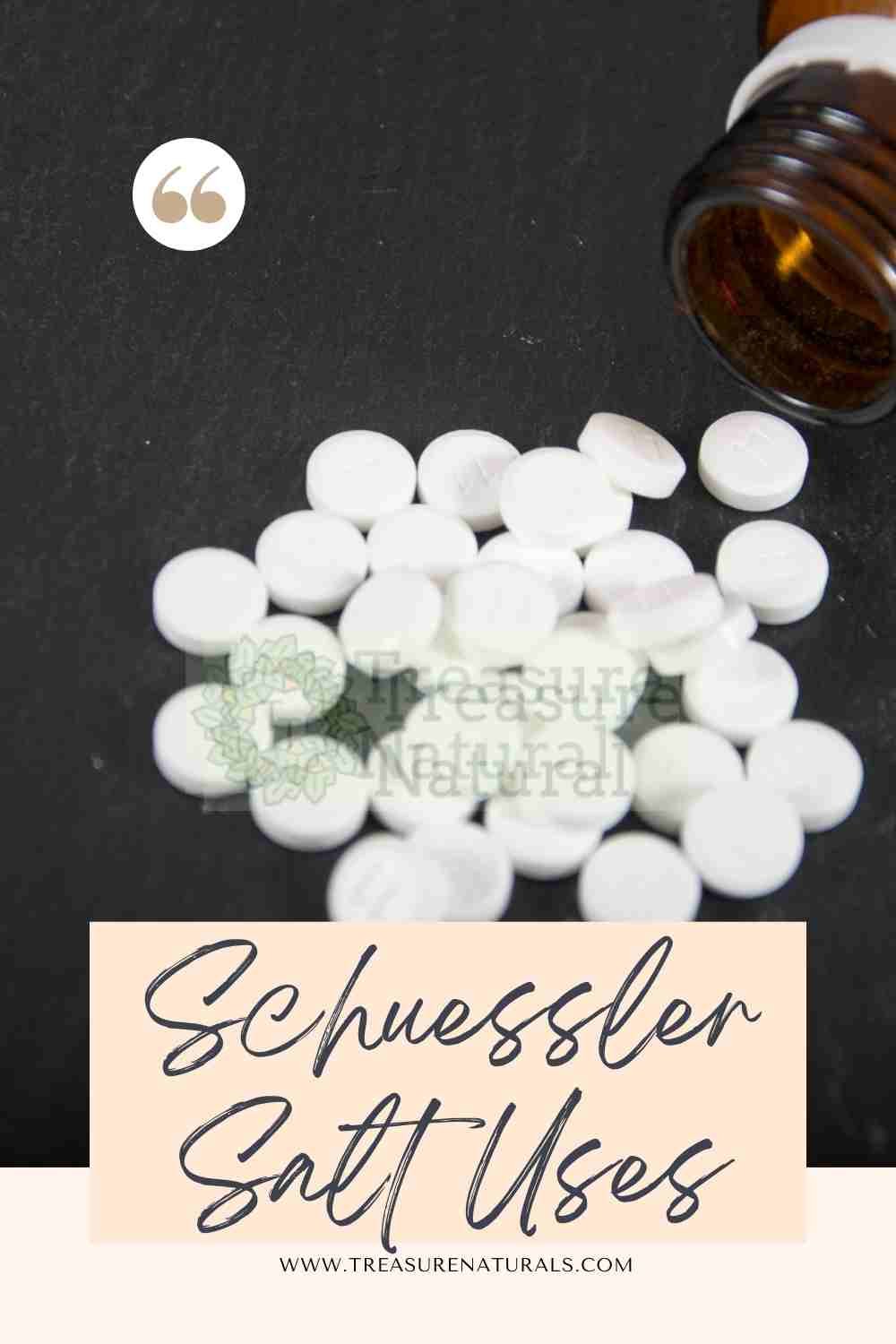Schuessler Salt
The Schuessler salts are an alternative healing method that is close to homeopathy. Its founder is the German homeopathic doctor Dr. Wilhelm Heinrich Schüßler (1821 to 1898), who originally wanted to simplify homeopathic treatment with around 200 remedies.
Here you will find the complete Schuessler salts list and learn everything you need to know about the use of the Schuessler Salts.
List of 12 Schuessler salts at a glance
The twelve salts are now summarized under the term “functional agent” – from No. 1 Calcium fluoratum to No. 12 Calcium sulfuricum. They promise improvement in acute health problems such as loss of appetite, hoarseness or toothache.
The twelve Schuessler salts at a glance:
- Schuessler Salt No. 1 Calcium fluoratum: Occurs in skin, tooth enamel or bones
- Schuessler Salt No. 2 Calcium phosphoricum: Contained in all body cells
- Schuessler Salt No. 3 Ferrum phosphoricum: Component of blood, muscles and intestines
- Schuessler Salt No. 4 Potassium chloratum: Occurs in almost all body cells and glands
- Schuessler Salt No. 5 Potassium phosphoricum: Important for the brain, nerves, muscles, blood and lymph
- Schuessler Salt No. 6 Potassium Sulfuricum: Contained in the skin, muscles and glands
- Schuessler Salt No. 7 Magnesium phosphoricum: Component of muscles, blood, nerves, brain, spinal cord, bones and teeth
- Schuessler salt no. 8 sodium cloratum: Regulates the absorption and release of water by the cells
- Schuessler Salt No. 9 Natrum phosporicum: Occurs in blood, muscles, nerve and brain cells as well as lymph
- Schuessler Salt No. 10 Natrum sulfuricum: Contained in the liver and bile
- Schuessler Salt No. 11 Silicea: Component of connective tissue, skin and mucous membranes, hair, nails, bones and nerves
- Schuessler Salt No. 12 Calcium sulfuricum: Contained in the liver and bile
List of Supplementary Schuessler salts
After the death of dr. Schuessler, these Schuessler salts established themselves as an independent healing method, which became increasingly widespread. Some of his followers then introduced twelve more minerals. Today they are summarized under the term “supplements”. They include:
- Schuessler Salt No. 13 Potassium arsenicosum
- Schuessler salt no. 14 potassium bromatum
- Schuessler Salt No. 15 potassium iodate
- Schuessler Salt No. 16 Lithium chloratum
- Schuessler Salt No. 17 Manganum sulfuricum
- Schuessler Salt No. 18 Calcium sulfuratum
- Schuessler Salt No. 19 Cuprum arsenicosum
- Schuessler salt no. 20 potassium aluminum sulfuricum
- Schuessler Salt No. 21 Zincum chloratum
- Schuessler Salt No. 22 Calcium carbonicum Hahnemanni
- Schuessler Salt No. 23 sodium bicarbonicum
- Schuessler Salt No. 24 Arsenicum jodatum
What are Schuessler salts?
In his research, Dr. Schüßler focused on twelve minerals and examined their occurrence and importance in the human body. He discovered that functional organ disorders are often based on a lack of one or more of these minerals.
To treat disorders, Dr. Schüßler provides his patients with the missing minerals – not in high doses, but in homeopathic potency. While in homeopathy the remedies are used as a stimulus, they serve as a substitute in the healing concept of the Schuessler salts. This means that the Schuessler salt used compensates for an existing mineral deficiency.
But: If you suffer from a significant mineral deficiency, Schuessler salts alone are not sufficient as a substitute. In addition to the Schuessler salts, you must in this case take the corresponding minerals, for example through food or dietary supplements – preferably in consultation with your doctor.
The task of the Schuessler salts is rather a regulating one. For example, they should help the cells to better absorb and distribute the corresponding mineral salts and thereby optimize the metabolic functions of the cells and organs.
Schuessler salts: production
The minerals in the Schuessler salts are produced according to homeopathic recipes. This means: They are first diluted, then succussed and then given the appropriate dilution designations. Schuessler salts are available in 3X, 6X or 12X potencies. However, the use of the D3 is rare. The most common potency in Schuessler salts is 6X. The degree of dilution at D6 is 1:1,000,000.
The difference to homeopathic remedies is, among other things: With the Schuessler salts, larger amounts are taken at shorter intervals.
Schuessler salts: the most important forms
Schuessler salts are available in various dosage forms. The most common are tablets, but powder, globules, chewable tablets and alcoholic drops are also available. For external use there are, among other things, Schuessler salt ointments, lotions or gels.
Schuessler salts: lactose-free?
Milk sugar (lactose) is used as the carrier substance for the Schüßler salt tablets. In contrast to an allergy, small amounts of milk sugar are usually tolerated in the case of lactose intolerance – for example one tablet three times a day.
In the case of severe lactose intolerance, Schuessler salt globules (granules made from cane sugar), alcoholic drops (dilutions) or chewable tablets can be used. In the case of globules and drops, five units must be calculated for one tablet.
Note: Due to the alcohol content, the drops are not suitable for children or (dry) alcoholics!
Other ingredients of Schuessler salt
In addition to lactose, the tablets may also contain wheat starch and other excipients. If you are sensitive or even allergic to it, you should speak to your doctor before using the Schuessler salts.
Schuessler Salts: How is remedy selected?
Therapists decide which Schuessler salts are the right choice and when, primarily on the basis of what is known as facial analysis, also known as facial diagnosis. This was developed by the German alternative medicine doctor Kurt Hickethier. It should enable the therapist to read mineral deficiencies in the patient’s face. He is guided by the colour, shape, wrinkles and luster of the face.
In addition, there are other ways to find out the minerals you need, for example with the help of kinesiology or based on individual preferences and dislikes regarding food and beverages – such as milk, smoked products or chocolate. From this, indications of certain mineral deficiencies can be derived.
In acute illnesses, Schuessler salts are usually selected based on the symptoms, such as Schuessler salts No. 3 for throbbing headaches and No. 8 for dull headaches caused by dehydration.
There are also preparations that combine different minerals and cures that are taken over several weeks – such as a spring or immune system cure. Such a Schuessler salt cure is usually combined with other measures, such as drinking certain types of tea.
Schuessler salts: application
For acne, abdominal pain or hair loss: Schuessler salts are said to help against various complaints. Certain Schuessler salts can also be used during pregnancy.
Schuessler salts: dosage
As a rule, Schuessler salts are started with a D6 – except for Calcium fluoratum, Ferrum phosphoricum, Silicea and the supplements, which are usually administered as D12.
The literature contains different information on dosage. It is best to talk to your pharmacist, naturopath or doctor about what is right for you.
General dosage suggestions, based on years of experience, include the following:
- For adults and children over the age of twelve, one to two tablets three times a day are recommended for mild or chronic problems.
- For more severe problems, it is possible to take a tablet at least once an hour.
- In acute cases, according to the recommendations, it is permitted to take one tablet every five minutes. But be careful: Schuessler salts should not be taken in large quantities, since the intake of calcium, potassium or sodium can be dangerous.
- According to recommendations, children under the age of twelve and infants should be able to take one to three tablets a day. For infants, you should dissolve the Schuessler salt tablet in a little water and spread the resulting porridge on the infant’s lips.
- Two tablets three times a day should be suitable for prophylaxis.
- Sensitive, older and particularly stressed people should start with a third of the specified dosage and increase the dose weekly.
As soon as the acute symptoms subside, the intervals between the doses are extended.
External use with ointments is also possible. In the case of chronic complaints, you can either apply the ointment thinly two to three times a day or you can make an ointment plaster or an ointment bandage (ointment on gauze).
In the case of severe inflammation, bruises, joint diseases, tendonitis or nerve pain, it is advisable to apply an ointment compress overnight.
A combined internal and external application with Schuessler salts is also possible. You can also grind up some tablets, mix them with some water and put them on the affected area as a wrap or compress.
Deviating from this information, the therapist can recommend a different Schuessler salt dosage in individual cases.
Schuessler salts: intake
Normally, Schuessler salt tablets or globules are taken individually and slowly dissolved in the mouth so that they are absorbed through the oral mucosa.
An exception applies to the “Hot Seven”, which is recommended for colic or cramp-like pain: First, 125 milliliters of water are boiled. Then dissolve seven to ten tablets of Schuessler Salt No. 7 Magnesium phosphoricum in it. The mixture should be drunk as hot as possible and in sips.
Food may impair the absorption of Schuessler salts through the oral mucosa. Therefore, take it before a meal or at least 15 minutes after it. During therapy with Schuessler salts, you should avoid consuming caffeine, nicotine, alcohol and hot spices.
If you want or should take two or three Schuessler salts, you can do this at different times – the first Schuessler salt in the morning, the second at noon and, if necessary, the third in the evening. Alternatively, distribute the various Schuessler salt intakes over different days.
Schuessler salts: effect and criticism
Schuessler salts are said to be able to fill mineral deficiencies within cells, but not those outside of cells. According to the concept of Schüßler salts, this requires “gross” preparations such as food supplements, electrolyte drinks or the like. Accordingly, only curable diseases and complaints that are based on a lack of a specific mineral can be treated.
In the case of irreparable damage, such as that which occurs with serious illnesses (cancer, multiple sclerosis, etc.), Schuessler salts are only intended to support the general well-being of the patient.
In general: The concept of Schuessler salts and their effectiveness has not been proven by independent scientific studies. Nevertheless, Schuessler salts are very popular as a gentle healing method.
Note:
The concept of Schuessler salts and their specific effectiveness are controversial in science and not clearly proven by studies.








